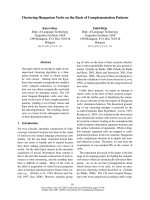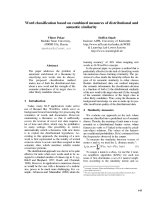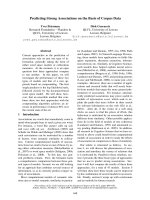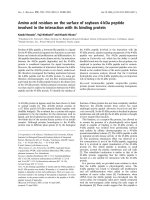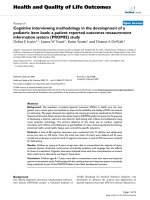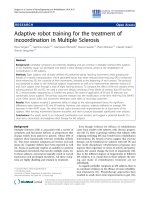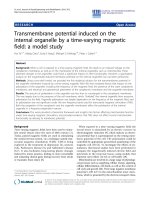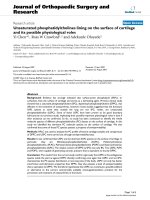báo cáo hóa học:" Unsaturated phosphatidylcholines lining on the surface of cartilage and its possible physiological roles" potx
Bạn đang xem bản rút gọn của tài liệu. Xem và tải ngay bản đầy đủ của tài liệu tại đây (257.13 KB, 6 trang )
BioMed Central
Page 1 of 6
(page number not for citation purposes)
Journal of Orthopaedic Surgery and
Research
Open Access
Research article
Unsaturated phosphatidylcholines lining on the surface of cartilage
and its possible physiological roles
Yi Chen*
1
, Ross W Crawford
1,2
and Adekunle Oloyede
2
Address:
1
Orthopedic Research Unit, Level 5, Clinical Science Building, Prince Charles Hospital, Rode Road, Chermside, Q 4032, Australia and
2
School of Engineering Systems, Queensland University of Technology, Gardens Point Campus, P.O. Box 2434, 2 George Street, Brisbane Q 4001,
Australia
Email: Yi Chen* - ; Ross W Crawford - ; Adekunle Oloyede -
* Corresponding author
Abstract
Background: Evidence has strongly indicated that surface-active phospholipid (SAPL), or
surfactant, lines the surface of cartilage and serves as a lubricating agent. Previous clinical study
showed that a saturated phosphatidylcholine (SPC), dipalmitoyl-phosphatidylcholine (DPPC), was
effective in the treatment of osteoarthritis, however recent studies suggested that the dominant
SAPL species at some sites outside the lung are not SPC, rather, are unsaturated
phosphatidylcholine (USPC). Some of these USPC have been proven to be good boundary
lubricants by our previous study, implicating their possible important physiological roles in joint if
their existence can be confirmed. So far, no study has been conducted to identify the whole
molecule species of different phosphatidylcholine (PC) classes on the surface of cartilage. In this
study we identified the dominant PC molecule species on the surface of cartilage. We also
confirmed that some of these PC species possess a property of semipermeability.
Methods: HPLC was used to analyse the PC profile of bovine cartilage samples and comparisons
of DPPC and USPC were carried out through semipermeability tests.
Results: It was confirmed that USPC are the dominant SAPL species on the surface of cartilage. In
particular, they are Dilinoleoyl-phosphatidylcholine (DLPC), Palmitoyl-linoleoyl-
phosphatidylcholine, (PLPC), Palmitoyl-oleoyl-phosphatidylcholine (POPC) and Stearoyl-linoleoyl-
phosphatidylcholine (SLPC). The relative content of DPPC (a SPC) was only 8%. Two USPC, PLPC
and POPC, were capable of generating osmotic pressure that is equivalent to that by DPPC.
Conclusion: The results from the current study confirm vigorously that USPC is the endogenous
species inside the joint as against DPPC thereby confirming once again that USPC, and not SPC,
characterizes the PC species distribution at non-lung sites of the body. USPC not only has better
anti-friction and lubrication properties than DPPC, they also possess a level of semipermeability
that is equivalent to DPPC. We therefore hypothesize that USPC can constitute a possible addition
or alternative to the current commercially available viscosupplementation products for the
prevention and treatment of osteoarthritis in the future.
Published: 23 August 2007
Journal of Orthopaedic Surgery and Research 2007, 2:14 doi:10.1186/1749-799X-2-14
Received: 17 April 2007
Accepted: 23 August 2007
This article is available from: />© 2007 Chen et al; licensee BioMed Central Ltd.
This is an Open Access article distributed under the terms of the Creative Commons Attribution License ( />),
which permits unrestricted use, distribution, and reproduction in any medium, provided the original work is properly cited.
Journal of Orthopaedic Surgery and Research 2007, 2:14 />Page 2 of 6
(page number not for citation purposes)
Background
Osteoarthritis is a disease that can compromise the func-
tionality of the primary load-processing tissue of joints,
namely articular cartilage. The cartilage tissue is covered
by a thin layer of surface-active phospholipid (SAPL) of
microscopic thickness that is believed to contribute to
lubrication [1] and load processing [2]. Surface-active
phospholipid is known more commonly as "surfactant"
in the lung, where it is produced by alveolar Type II cells
in the form of lamellar bodies, which are secreted onto the
alveolar surface [3].
Studies indicate that SAPL is also synthesized and secreted
in other parts of the body such as in the peritoneal cavity
and joints [4,5], where its adsorption on the surfaces of
tissues at these sites has been demonstrated using tech-
niques such as electron microscopy, epifluorescence
microscopy and autoradiography [6-8]. SAPL has also
been found in many other non-lung sites of the body
including the stomach and eustachian tube [9-11]. SAPL
retains highly desirable physical and physiological prop-
erties, including: reduction of surface tension [1,12,13],
physical barrier formation [11] and semipermeability
[14].
ALEC™ is the only commercially available exogenous
SAPL product that was developed initially for its clinical
application in treating Respiratory Distress Syndrome
(RDS) [15]. The main component of ALEC™ is a saturated
phosphatidylcholine (SPC) called dipalmitoyl-phos-
phatidylcholine (DPPC) that is the main component of
lung surfactant [3]. However, for a long time people had
assumed that the main component of SAPL at the non-
lung sites was also DPPC [1,8,9,11,13,15]. In these studies
SAPL were always digested into inorganic phosphorus. By
assuming all the phosphorus was coming from the DPPC
molecules in the SAPL sample, the DPPC content was cal-
culated by converting the amount of phosphorus into that
of DPPC simply through the differences in their molecular
weights. Subsequently several studies, including animal
studies [16,17] and a clinical trial [18], have also been car-
ried out to look at the efficacies of DPPC-based SAPL
products in their treatment of different medical disorders
at some non-lung sites. In particular, some promising
results were noticed in the clinical trial in which a DPPC-
based product was used to treat some osteoarthritis
patients [18].
Two previous studies have shown that the dominant SAPL
species at non-lung sites, such as the stomach and eus-
tachian tube, are not SPC, but unsaturated phosphatidyl-
choline (USPC) [19,20]. Since then studies of USPC have
been in two areas. The first is finding out real SAPL pro-
files at different non-lung sites such as the peritoneal cav-
ity and joints. The second is comparing and examining
whether USPC have the same or similar physical and
physiological properties compared to DPPC. The infor-
mation obtained from these two areas will be essential if
we were to exploit the possibility of using appropriate
SAPL for applications to alleviate medical disorders at
non-lung sites. So far, it has been confirmed that the dom-
inating SAPL species inside the peritoneal cavity are USPC
and two dominating USPC species, palmitoyl-linoleoyl-
phosphatidylcholine (PLPC) and palmitoyl-oleoyl-phos-
phatidylcholine (POPC), both of which possess anti-stick
and lubrication properties similar to, if not better than
those of DPPC [21]. Furthermore, the profile of SAPL spe-
cies inside the pleural cavity has been found to be also
dominated by USPC [22,23]. So far, there is no study
identifying different species of SAPL bound to the carti-
lage surfaces at the molecular level, though Sarma et al.
[24] tried to identify some PC species in an indirect way
by analysing fatty acid chains attached to phosphatidyl-
choline backbones. However, the results from this study
strongly suggested that USPC could be the dominating
species inside the joint.
The semipermeability system inside the joint is important
for fluid transport. As we already know, the PC lining on
the surface of cartilage could serve not only as an effective
lubricant but also as part of a whole semipermeable sys-
tem to facilitate fluid transport at this site. It could be rea-
sonably argued that when the PC lining on the cartilage
surface becomes deficient the whole semipermeable sys-
tem could be impaired, resulting in the abnormal accu-
mulation of fluid inside the joint, causing joint effusion.
In this study we investigated the SAPL profile in the joint
by analysing individual SAPL species as whole molecules.
We also compared the semipermeability imparted by
DPPC-based membranes to those made from particular
USPC species. The outcomes from this study will further
enhance our knowledge of SAPL profiles at non-lung sites.
It will also aid our understanding of whether or not USPC
species play any role in contributing to the physiological
functions of the joint, leading to potential insight into the
relationship between SAPL deficiency and articular carti-
lage function and degeneration.
Methods
Materials
Dipalmitoyl-phosphatidylcholine (DPPC), Dilinoleoyl-
phosphatidylcholine (DLPC), Palmitoyl-linoleoylphos-
phatidylcholine, (PLPC), Palmitoyl-oleoyl-phosphatidyl-
choline (POPC), Dioleoyl-phosphatidylcholine (DOPC)
and Stearoyl-linoleoylphosphatidylcholine (SLPC), Brij
35 (30% w/v), 1,6-diphenyl-1, 3, 5-hexatriene (DPH),
and choline chloride were all analytic grade (AR) grade
and were purchased from Sigma-Aldrich (Castle Hill,
NSW, Australia). Methanol, acetonitrile and chloroform
Journal of Orthopaedic Surgery and Research 2007, 2:14 />Page 3 of 6
(page number not for citation purposes)
were HPLC grade purchased from EM Science (Merck,
KGaA, Darmstadt, Germany).
Preparation of bovine cartilage SAPL
Bovine cartilage phosphatidylcholines (PC) were
extracted from the surface of ten articular cartilage speci-
mens which were taken from the patellar grooves of 3–4
year old bovine animals harvested from the local abattoir
on the experimental day. A standard lipid extraction pro-
cedure [25] was followed. The lipid solvent was chloro-
form: methanol (2:1), known as Folch reagent. During the
collection procedure, soft facial tissues soaked with Folch
solvent were used to wipe SAPL off from the articular sur-
face. The contact time between the solvent and articular
surface at each of these selected areas was all under 10 sec-
onds as our pretest showed that this time frame did not
cause any histological changes or damage to cartilage tis-
sues. All used facial tissues were pooled together and
soaked in Folch reagent. The chloroform phase containing
both PC and non-PC species were obtained. The PC and
non-PC species were then separated from each other by
using a 100 mg Bondelut
R
NH
2
disposable cartridge col-
umn (Varian, Mulgrave, Vic., Australia), a standard
method developed in a published study [26]. In brief, dur-
ing this purification procedure, chloroform solution con-
taining all the SAPL was allowed to pass through this
cartridge. Since the particles inside the cartridge have a
much stronger binding affinity to PC species than to non-
PC species, only the PC component can be retained inside
the cartridge and the non-PC component was eluted out
of the cartridge. The cartridge was then washed with chlo-
roform in order to eliminate any leftover non-PC compo-
nent inside the cartridge. PC components were then
eluted off by using chloroform/methanol (3:2, v/v). This
chloroform/methanol solution containing PC species was
used for subsequent HPLC assays.
HPLC analysis
A 1100-series HPLC system (Agilent Technologies, Forest
Hill, Vic., Australia) was used in combination with a RF-
10AXL fluorescent detector (Shimadzu, Kyoto, Japan).
Separations were screened on Phenosphere-NEXT C18
column (250 × 2 mm i.d., 5 µm particles) from Phenom-
enex Pty Ltd (Pennant Hills, NSW, Australia). The chro-
matographic conditions were based on those used in a
published study [27]. The mobile phase was methanol
(92.5% v/v) and water (7.5% v/v) with or without 40 mM
choline chloride. The flow rate was 0.6 mL/min. The elu-
ent was monitored by a fluorescent detector at 340/460
nm (excitation/emission) after post-column derivatiza-
tion of mixed micelles with DPH using a 100 cm reaction
coil at 50°C. The injection volume was 10 µl. The stand-
ard curves for all five PC species were all linear over the
ranges of 5–25 mg/L and their correlation coefficients (r)
were > 0.98. No internal standard was used. The inter-
assay and intra-assay coefficients of variation were all <
10%. The recovery rates of all five PC species were > 80%.
The detection limit for all five PC species was 50 ng. The
relative percentages of each of the PC species were calcu-
lated after dividing their individual amount by the total
PC amount.
Measurement of semipermeability
Based on experience obtained from our previous study
[14], 54 µl of individual synthetic PC (PLPC, POPC and
DPPC) chloroform solution at a concentration of 21.85
mg/ml was deposited on each side of a disc of white nylon
filter paper with a pore diameter of 0.2 µm (Millipore Cor-
poration, Bedford, MA, U.S.A.). This was the carrier used
to produce the PC semipermeable membrane. The solvent
was removed by evaporation and the weight deposited per
unit area was recorded as the effective "thickness". The
achieved effective membrane thickness was 2.36 mg
which was proven to be sufficient to cover the exposed
area of 0.95 cm
2
.
Osmotic pressure was generated by clamping a PC mem-
brane prepared as mentioned above between the two
compartments of an Ussing chamber (Jim's Instrument
Manufacturing, Iowa City, IA, U.S.A.). The left compart-
ment was always filled with saline (sodium concentration
of 0.15 M) and the right with hypertonic glucose solution
(0.139 M) that was used in our previous similar study
[14]. The total capacity of each compartment was approx-
The structure of the 'osmometer' is illustrated, which con-sists of an Ussing chamber with two compartments holding test solution and saline separately, two vertical tubes con-nected to each of two compartments and used as osmotic pressure indicators, a SAPL membrane, and test/saline solu-tionsFigure 1
The structure of the 'osmometer' is illustrated, which con-
sists of an Ussing chamber with two compartments holding
test solution and saline separately, two vertical tubes con-
nected to each of two compartments and used as osmotic
pressure indicators, a SAPL membrane, and test/saline solu-
tions. The "membrane" is clamped between the two com-
partments of an Ussing chamber. The test solution in the
right compartment is "dialyzed" against saline in the left com-
partment.
Saline
Test Solution
Pressure Difference
(¨P)
OSMOMETER
SAPL
MEMBRANE
Journal of Orthopaedic Surgery and Research 2007, 2:14 />Page 4 of 6
(page number not for citation purposes)
imately 0.7 ml, and the contact area between the two com-
partments was 0.44 cm
2
. 2.36 mg of DPPC or PLPC or
POPC were used. Two vertical tubes with inner diameters
of 1.2 mm were connected to the side of each compart-
ment to measure osmotic pressure head. Figure 1 illus-
trates the device.
Osmotic pressure was measured as the difference in
hydrostatic pressure of the compartments needed to stop
further water transmission across the membrane. At the
beginning of each experiment, the fluid heights indicating
the pressure in both compartments, i.e. either sides of the
membrane were set to the same level. The whole device
was maintained at 37°C in a water bath, and the fluid
heights indicating osmotic pressure difference (∆P) were
measured and recorded until no further movement of
fluid was seen. At the end of each experiment, the final
pressure difference, ∆P, was recorded as the difference in
the heights between the two fluid columns. The mean and
standard error of the mean (SEM) were calculated for each
group of data points and the one-way ANOVA test was
used for statistical analysis.
Experimental procedure for osmosis testing
The experiment was divided into three sections:
Section I (n = 8): Measurement of osmotic pressure pro-
duced by dialyzing saline against hypertonic glucose solu-
tion (0.139 M) using a DPPC "membrane" of "thickness"
2.36 mg. Section II (n = 8): Measurement of osmotic pres-
sure produced by dialyzing saline against hypertonic glu-
cose solution (0.139 M) using a PLPC "membrane" of
"thickness" 2.36 mg. Section III (n = 8): Measurement of
osmotic pressure produced by dialyzing saline against
hypertonic glucose solution (0.139 M) using a POPC
"membrane" of "thickness" 2.36 mg.
Results
Four USPC species and DPPC were identified from bovine
cartilage samples assayed by our HPLC analysis. The total
amount of PC was then worked out by adding the
amounts of individual PC species together. In our study
the total amount of PC species was < 20 µg. The relative
percentages of each of the PC species were calculated after
dividing their individual amount by the total PC amount.
The individual relative percentages of these four USPC
species were 23% for DLPC, 30% for PLPC, 17.5% for
POPC and 16.0% for SLPC. The content of DPPC was
found only to be 8%.
In each of the eight runs using synthetic DPPC, PLPC and
POPC membranes, the hypertonic glucose solution gener-
ated osmotic pressure differences (∆P) averaging 1.70 ±
0.07, 1.69 ± 0.08 and 1.34 ± 0.05 cm H
2
O (N = 8). These
results are shown in Figure 2. The ANOVA analysis
showed that a significant difference existed in these three
groups (P = 0.002). Subsequently, student t-tests were car-
ried out to compare the three pairs, PLPC and DPPC,
POPC and DPPC, and PLPC and POPC, separately. There
were significant differences between POPC and DPPC (p
= 0.002), and PLPC and POPC (p = 0.003). There was no
significant difference between PLPC and DPPC (p = 0.80).
Discussion
Several published studies have indicated that 1) there is
endogenous SAPL lining on the surface of cartilage; 2) this
SAPL is a good agent for antistick and lubrication; 3) the
exogenous SAPL can be reversibly adsorbed onto the sur-
face of cartilage and 4) the adsorbed exogenous SAPL
could be effective in the treatment of osteoarthritis. As
mentioned earlier, recent studies have also discovered that
USPC was the dominant species at two non-lung sites ie
the peritoneal cavity and pleural cavity.
Our results from this study strongly indicated that the
dominant PC species on the surface of cartilage were
USPCs, ie DLPC, PLPC, POPC and SLPC, representing a
very different SAPL profile from that of inside the lung
where DPPC (SPC) is the dominant species. The most
interesting and important finding from our current study
was that SAPL on the surface of articular cartilage con-
tained on average only 8% DPPC. We therefore speculate
that the role of DPPC at this non-lung site might be negli-
gible especially when compared to the fact that DPPC
constitutes ~60 % of all PC species in the lung regions of
the body. The present results offer further support to the
In this figure, the three bars represent the mean osmotic pressure difference (∆P) generated by three SAPL "mem-branes", two of which were made with synthetic USPC ie POPC and PLPC, and one with synthetic SPC ie DPPCFigure 2
In this figure, the three bars represent the mean osmotic
pressure difference (∆P) generated by three SAPL "mem-
branes", two of which were made with synthetic USPC ie
POPC and PLPC, and one with synthetic SPC ie DPPC.
There was no significant difference of ∆P between PLPC and
DPPC 'membranes' was found (p < 0.05) though a significant
difference was noticed between POPC and DPPC 'mem-
branes' (p > 0.05).
1.0
0
POPC
2.0
PLPC DPPC
¨P
(cmH
2
O)
Journal of Orthopaedic Surgery and Research 2007, 2:14 />Page 5 of 6
(page number not for citation purposes)
opinion that USPC could be the dominant PC species in
most, if not all non-lung sites.
Our findings can also be supported by the results
obtained by Sarma et al. [24], in which the fatty acid con-
centrations were measured after separating them from
their phosphatidylcholine backbones. It was found that
the total percentage of all saturated fatty acids was about
39% and the majority of fatty acids were unsaturated fatty
acids (61%). As two fatty acids are needed to form an
intact SPC or USPC molecule, DPPC requires two satu-
rated fatty acids, ie palmitic acid. PLPC, POPC and SLPC
require one saturated fatty acid, either palmitic or stearic
acid, and one unsaturated fatty acid, either linoleic or oleic
acid. In the case of DLPC it requires two unsaturated fatty
acids, ie linoleic acid. By following this rule, the percent-
ages of total saturated and unsaturated fatty acids in our PC
samples can be calculated to be around 42% and 58%
respectively, which were very close to those reported in the
study mentioned above [24].
On the basis of this species identification, we proceeded
to carry out semipermeability studies on two USPC spe-
cies, ie PLPC and POPC, and compared them to DPPC.
Statistically, no difference was found in mean osmotic
pressure differences (∆P) between PLPC and DPPC (p =
0.80), though there was a significant difference between
POPC and DPPC (p = 0.002). However, the mean osmotic
pressure differences (∆P) among these three SAPL were
very similar. These results were encouraging, in that they
demonstrate that PLPC and POPC, the two dominating
USPC species on the surface of cartilage, have equivalent
or similar semipermeability properties to that of DPPC.
This finding plus our previous findings [21-23] are impor-
tant because we now know that the endogenous SAPL spe-
cies inside the joint are mainly USPC and these USPC
have properties of antistick, lubrication and semiper-
meability.
DPPC is the main PC species in lung SAPL or surfactant.
The obvious reason for this is that DPPC has a gel-liquid
crystal transition temperature of 41.5°C, which effectively
makes it a rigid molecule at body temperature and is
therefore more capable in reducing surface tension. At
non-lung sites, surface tension reduction is not a physio-
logical requirement; therefore, it is not surprising to find
out that the relative quantity of DPPC in total PC species
found at non-lung sites such as in the eustachian tube,
stomach, peritoneal cavity and pleural cavity are all much
lower than that of the lung [19-23,28].
Results from our current and previous studies indicate
that SAPL, especially the USPC species i.e. PLPC and
POPC, could be the important components in maintain-
ing normal physiological functions of joint cartilage. The
SAPL molecule is actually a zwitterion containing a
strongly positively charged quaternary ammonium ion at
one end which could enable it to bind to most epithelial
surfaces which are negatively charged [29]. Besides the
confirmed anti-friction/lubrication properties [21], these
USPC species could also be an important component of
the whole semipermeability system in regulating water
transport in the joint by strongly binding to negatively
charged proteoglycans. In addition, the SAPL lining that
covers the intracellular gaps may be a necessity for the
whole semipermeability system to be functional because
proteoglycans alone may not be sufficient.
Based on the research data we have obtained so far we
believe that it is worthwhile to carry out animal studies to
further test the efficacy of USPC-containing SAPL samples
for their properties of lubrication and semipermeability.
Competing interests
The author(s) declare that they have no competing inter-
ests.
Authors' contributions
YC contributes to the conception and design, the conduc-
tion of the experiment, the collection, analysis and inter-
pretation of data, the drafting the manuscript and
acquisition of funding.
RWC contributes to the analysis and interpretation of
data, drafting the manuscript and acquisition of funding.
AO contributes to the analysis and interpretation of data,
drafting the manuscript and acquisition of funding.
All authors have read and approved the final manuscript.
Acknowledgements
The authors would like to thank Smith & Nephew Australia and USA, the
Prince Charles Hospital Foundation for funding this project, and the late
Professor Brian Hills for his pioneering work in this area of research.
References
1. Hills BA: Oligolamellar nature of the articular surface. J Rheu-
matol 1990, 17:349-56.
2. Oloyede A, Gudimetla P, Crawford R, Hills BA: Consolidation
responses of delipidized articular cartilage. Clin Biomech 2004,
19(5):534-42.
3. Stratton CJ: Morphology of surfactant producing cells and of
the alveolar lining. In Pulmonary Surfactant Edited by: Robertson K,
van Golde L MG, Battenburg JJ. Amsterdam, Elsevier; 1984:68-118.
4. Dobbie JW, Pavlina T, Lloyd J, Johnson RC: Phosphatidylcholine
synthesis by peritoneal mesothelium: Its implications for
peritoneal dialysis. Am J Kidney Dis 1988, 12:31-6.
5. Schwarz IM, Hills BA: Synovial surfactant: lamellar bodies in
type B synoviocytes and proteolipid in synovial fluid and the
articular lining. Br J Rheumatol 1996, 35:821-7.
6. Ueda S, Kawamur K, Ishi N, Matsumot S, Hayashi K, Okayasu M, Saito
M, Sakurai I: Ultrastructural studies on surfaces lining layer of
the lungs. Part IV. Resected human lung. J Jpn Med Soc Biol Inter-
face 1985, 16:36-60.
Publish with BioMed Central and every
scientist can read your work free of charge
"BioMed Central will be the most significant development for
disseminating the results of biomedical research in our lifetime."
Sir Paul Nurse, Cancer Research UK
Your research papers will be:
available free of charge to the entire biomedical community
peer reviewed and published immediately upon acceptance
cited in PubMed and archived on PubMed Central
yours — you keep the copyright
Submit your manuscript here:
/>BioMedcentral
Journal of Orthopaedic Surgery and Research 2007, 2:14 />Page 6 of 6
(page number not for citation purposes)
7. Hills BA: Graphite like lubrication of mesothelium by oligola-
mellar pleural surfactant. J Appl Physiol 1992, 73:1034-39.
8. Chen Y, Hills BA: Surgical adhesions: Evidence for adsorption
of surfactant to peritoneal mesothelium. Aust NZ J Surg 2000,
70:443-7.
9. Hills BA: A common physical basis for the gastric mucosal
barrier and the action of sucralfate. Am J Med 1991, 91:43-9.
10. Birken EA, Brookler KH: Surface tension lowering substance of
the canine Eustachian tube. Ann Otol Laryngol 1972,
81(2):268-271.
11. Hills BA, Monds MK: Deficiency of lubrication surfactant lining
the articular surface of replaced hips and knees. Br J Rheumatol
1998, 37:143-7.
12. Clements JA: Surface tension of lung extracts. Proc Soc Exp Biol
Med 1957, 95:170-2.
13. Hills BA, Burke JR, Thomas K: Surfactant barrier lining perito-
neal mesothelium: Lubricant and release agent. Perit Dial Int
1998, 18:157-65.
14. Chen Y, Burke JR, Hills BA: Semi-permeability imparted by sur-
face-active phospholipid (SAPL) in peritoneal dialysis. Perit
Dial Int 2002, 22:380-5.
15. Morley CJ, Bangham AD, Miller N, Davis JA: Dry artificial lung sur-
factant and its effects on very premature babies. Lancet 1981,
1:64-8.
16. Ar'Rajab A, Snoj M, Larsson K, Bengmark S: Exogenous phosphol-
ipid reduces postoperative peritoneal adhesions in rats. Eur J
Surg 1995, 161:341-4.
17. Bhandarkar DS, Nathanson LK, Hills BA: Spray of phospholipid
powder reduces peritoneal adhesion in rabbits. Aust NZ J Surg
1999, 69:388-90.
18. Vecchio P, Thomas R, Hills BA: Surfactant treatment for oste-
oarthritis. J Rheumology 1999, 38:1020-1.
19. Bernhard W, Postle AD, Linck M, Sewing KF: Composition of
phospholipid classes and phosphatidylcholine molecular spe-
cies of gastric mucosa and mucus. Biochim Biophys Acta 1995,
1255:99-104.
20. Paananen R, Postle AD, Clark G, Glumoff V, Hallman M: Eustachian
tube surfactant is different from alveolar surfactant: deter-
mination of phospholipid composition of porcine eustachian
tube lavage fluid. J Lipid Res 2002, 43:99-106.
21. Chen Y, Hills BA, Hills YC: Unsaturated phosphatidylcholine
and its application in surgical adhesion. Aust NZ J Surg 2005,
75:1111-4.
22. Mills PC, Chen Y, Hills YC, Hills BA: Differences in surfactant lip-
ids collected from canine pleural and pulmonary lining fluids.
Pharm Res 2005, 22(11):1926-1930.
23. Mills PC, Chen Y, Hills YC, Hills BA: Comparison of surfactant
lipids between pleural and pulmonary lining fluids in the cat.
Pulm Pharmacol Ther 2006, 19(4):292-296.
24. Sarma AV, Powell GL, LaBerge M: Phospholipid composition of
articular cartilage boundary lubricant. Journal of Orthopaedic Res
2001, 19(4):671-676.
25. Folch J, Lees M, Sloane-Stanley GH: A simple method for the iso-
lation and purification of total lipids from animal tissues. J
Biol Chem 1957, 226:497-509.
26. Caesar PA, Wilson JS, Normand ICS, Postle AD: A comparison of
the specificity of phosphatidylcholine synthesis by human
fetal lung maintained in either organ or organotypic culture.
Biochem J 1988, 253:451-7.
27. Bernhard W, Linck M, Creutzhurg H, Postle AD, Arning A, Martin-
Carrers I, Sewing KFr: High-performance liquid chromato-
graphic analysis of phospholipids from different sources with
combined fluorescence and ultraviolet detection. Anal Bio-
chem 1994, 220:172-80.
28. Bernhard W, Postle AD, Rau GA, Freihorst J: Pulmonary and gas-
tric surfactants. A comparison of the effect of surface
requirements on function and phospholipid composition.
Comp Biochem Physiol A Mol Integr Physiol 2001, 129:173-82.
29. Hills BA: Role of surfactant in peritoneal dialysis. Perit Dial Int
2000, 20:503-15.
